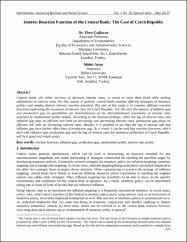Interest reaction function of the central bank: The case of Czech Republic
Künye
Çağlayan, Ebru; Astar, Melek. Interest reaction function of the central bank: The case of Czech Republic. International Journal of Business and Social Science, Vol. 3, Issue 10, pp. 225-232.Caglayan E, Astar M. Interest Reaction Function of the Central Bank: The Case of Czech Republic. International Journal of Business and Social Science. 2012; 3(10): 225-232.
Özet
Central banks will either increase or decrease interest rates, or resort to leave them fixed while making adjustments on interest rates. For this reason, in general, central banks examine different strategies of monetary politics and employ distinct interest reaction functions. The aim of this study is to examine different reaction functions explicating the movement of interest rates for Czech Republic. For this aim, the impacts of inflation gap and production gap on possibilities for materialization of the abovementioned movements of interest rates analyzed by multinomial probit models. According to the attained findings, while the lag of interest rates and inflation gap play an efficient role both on increasing and decreasing interest rates, production gap plays an efficient role only on increasing interest rates. Besides, it is possible to say that the lag of interest rate and inflation gap have further effect than of production gap. As a result, it can be said that reaction functions, which deal with inflation gap, production gap and the lag of interest rates for monetary politicians of Czech Republic, will be a good and simple guide.


















